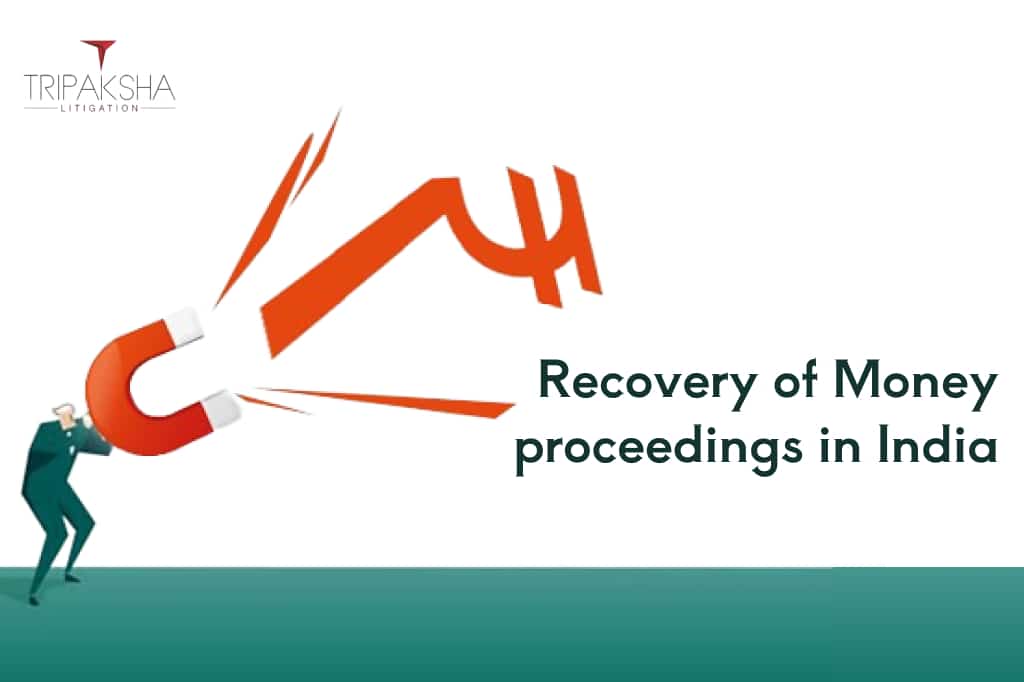Recovery cases are the Legal proceedings which are initiated by the financial Creditor from the Debtor. With the rise of Digitalization, Globalization, Commercialization, every business in the market is taking loan and transferring the money and this in fact became a necessity and this is in the form of taking Loans from the banks, Individuals. However, things become difficult when the borrower/debtor fails to repay or fails to discharge his financial & legal obligation. At this, the Lendor, Creditor, Complainant, Aggrieved person has to look for Legal Methods to Recover the Money. Below are the relevant legal Provisions which deals the recovery of the Money in India.
1. Summary suit under the Code of Civil Procedure, 1908
Order XXXVII of the Code of Civil Procedure, 1908 lays down the procedure for filing and adjudication of Summary Suits. The main objective of a summary suit is to provide for a quick and efficient legal remedy to recover debts or liquidated demands without going through the normal process of a regular civil suit. The Summary Suit is only available for cases where the Plaintiff’s claim is a debt or a liquidated demand that arises out of written contract, an enactment or on a Guarantee. This means that if the plaintiff’s claim does not fall within this category, they cannot file a summary suit.
Key points to remember while filing summary suits: –
- Applicable courts – High Courts (as per the pecuniary jurisdiction of respective state), City Civil Courts (as per the pecuniary jurisdiction of respective City/Area/District/Tehsil), Courts of Small Causes ( as per the pecuniary jurisdiction of the concerned City/Area/District/Tehsil), and others as specified under the Law.
- Types of cases – suits on Bills of Exchange, Hundis, Promissory Note, Written Contracts Or Guarantees.
- Procedure for filing – Plaint must specifically state it’s filed under Order XXXVII CPC.
- Defendant’s response – Defendant must appear within 10 days of Summons Service.
- Judgement conditions – Judgement for plaintiff if defendant fails to appear or defend.
2. Suit For Recovery Under Code Of Civil Procedure, 1908
Civil Remedy for the recovery of money is by way of institution of a suit in a court of appropriate jurisdiction. The suit can be instituted under Order IV of the Code of Civil Procedure 1908. Key points to remember while filing suit for recovery
- Jurisdiction – A suit can be instituted at the place where the Defendant Resides or Defendant Carries on Business or Personally Works for gain or the Cause of Action wholly or partly arises.
- Limitation – Suit can be filed within 3 years from the date of Cause of Action having arisen. The said period of limitation cannot be condoned. A suit is instituted by way of a Plaint. Plaint is the description of facts of the case and the exact amount being claimed along with any interest
- Documents required – the Plaint is to be accompanied by the supporting documents viz, Written Contract, Particulars of Claim and correspondences if any. This plaint is required to be proved by way of an accompanying affidavit and an appropriate verification of the facts.
- Court Fee –Court Fee as per the schedules is required to be paid by the Plaintiff. A suit shall be returned in case the same is not filed along with the court fee.
3. Dishonour Of Cheque Under The Negotiable Instruments Act, 1881
Section 138 of the Act deals with the punishment for the dishonour of the cheque. The cheque is a negotiable instrument drawn on a specified banker and not expressed to be payable otherwise on demand. Section 6 of the NI Act makes it clear that this definition of a cheque includes an electronic image of a truncated cheque and a cheque in electronic form. The following ingredients should be there:
- There should be a Drawer that draws the cheque.
- The cheque drawn should be in discharge of some legally recoverable liability.
- Presentation of cheque to the drawee bank.
- The cheque returned by the bank on account of dishonour due to various reasons.
- The cheque should be presented within six months from the date on which it was drawn or within the period of its validity, whichever is earlier.
- Within thirty days of receiving a memo of return from the bank, a notice should be served to demand the payment of the said money.
- The drawer fails to pay the said money within 15 days of the receipt of the said notice.
- The offence is said to be committed under section 138 of the NI Act, only when he fails to pay the debt within 15 days and such person shall be punishable with imprisonment for a term which may be extended to two years, or with a fine which may extend to twice the amount of the cheque, or with both.
4. Commercial Suit Under The Commercial Courts Act, 2015
Act was introduced with the intent to facilitate long pending commercial disputes. The new act allows the debtor to file a commercial suit as an alternative effective remedy irrespective of the availability of the traditional one. The choice of filing of the suit now lies with the litigator whether to move a petition under commercial courts act or civil procedure code. Section 2(1)(c) of the act defines the term ‘Commercial Dispute’ wherein the financial creditors are covered within the ambit of section 2(1)(c)(i) as follows: “(i) ordinary transactions of merchants, bankers, financiers and traders such as those relating to mercantile documents, including enforcement and interpretation of such documents”. The following ingredients should be there:
- A Suit, which does not contemplate any urgent interim relief under this Act, shall not be instituted unless the plaintiff exhausts the remedy of pre-institution mediation in accordance with such manner and procedure as may be prescribed by rules made by the Central Government.
- The Authority authorised by the Central Government shall complete the process of mediation within a period of three months from the date of application made by the plaintiff.
- The period of mediation may be extended for a further period of two months with the consent of the parties.
- The claim of the Plaintiff must exceed 3 lakhs to file the plaint under Commercial Courts Act,2015.
- COMPANIES ACT, 2013
Provisions enacted under Companies Act, 2013 for recovery are as follows:
1. Section 362: Sale of assets and recovery of debts due to company
In case a company is undergoing liquidation. An Official Liquidator is appointed by the court to manage the process. This Official Liquidator is required to sell off all the company’s assets, such as furniture, computers and company cars, within 60 days of his appointment to ensure a quick resolution. The Official Liquidator must notify all individuals or entities that owe money to the company to pay their dues within 30 days. If the vendor ignores the notice and fails to pay, the Official Liquidator can ask the central Government to intervene and take appropriate action to ensure that the money owed is paid to assist in settling the company’s debts. Any money that the Official liquidator collects from the sale of assets or recovery from debtors must be deposited as specified under the act, which may involve putting the funds into a specific bank account designated for the liquidation process.
2. Section 199 Recovery of Remuneration In Certain Cases
Where a company is required to restate its financial statements due to fraud or non-compliance with any requirement under this act and the rules made thereunder, the company shall recover from any past or present managing director or whole-time director or manager or Chief Executive Officer (by whatever name called) who, during the period for which the financial statements are required to be re-stated, received the remuneration (including stock option)in excess of what would have been payable to him as per restatement of financial statements.
6. Recovery of Debts Due to Banks and Financial Institution Act, 1993 (RDDBFI)
Banks and financial institutions duly registered with the Reserve Bank of India (RBI) provide loan facility to legal entities and individuals (borrowers). In the event where the borrower fails to repay loan amount or any part thereof which also includes unpaid interests and other charges and/or debt becomes Non-Performing Asset (NPA), banks and financial institutions can recover the debt by approaching Debt Recovery Tribunal.
Types of pleadings/applications generally filed before DRT
- Original Application (O.A) refers to the claim filed by the bank or financial institution for recovery of debt from the borrower.
- Interlocutory Application (I.A) refers to the applications filed during the pendency of the case.
- Miscellaneous Interlocutory Application (Misc. I.A) refers to the applications filed under clause h of section 22(2) of the RDDBFI Act.
- Written Statement /reply refers to defence of the borrower.
Section 19 of the RDDBFI Act, conditions are laid down in respect of filing an Application to DRT. The application can be filed by a bank or financial institution to a DRT, that has the jurisdiction, and where the defendant either resides or carries out his business. Moreover, an application can also be filed with a DRT, it the cause of action arises wholly or partly within the limits of the jurisdiction. Along with the application, the prescribed fee needs to be paid.
The application made to a DRT warrants summons to be issued to the defendant to show cause within 30 days as to why the prayed relief should not be granted. The defendant must turn in a written submission, for which extra time can be granted by the Tribunal. A defendant can also file a counter claim against the complainant with respect to the alleged sum of money, but only in the first hearing, except also in cases where the tribunal explicitly grants such permission.
Based on the DRT’s order, the Presiding Officer(P.O) shall issue a Certificate to the Recovery Officer (R.C.) to recover the debt amount, which has been specified in it, the Recovery officer may attach, sell or appoint a receiver for the management of the defendant’s property, in order to recover the debt. Moreover, the DRTs also possess the power to obtain a police warrant to arrest the defendant in these cases.
Where a bank or a financial institution, which has to recover its debt from any person, has filed an O.A and against the same person another bank or financial institution also has claim to recover its debt, then, the later bank or financial institution may join the applicant bank or financial institution at any stage of the proceedings, before the final order is passed, by making an application to that DRT.
7. Securitization and Reconstruction of Financial Assets and Enforcement of Security Interest Act, 2002 (SARFAESI)
The SARFAESI Act allows banks and other financial institutions for auctioning commercial or residential properties to recover a loan when a borrower fails to repay the loan amount. Thus, the SARFAESI Act, 2002 enables banks to reduce their Non-Performing Assets (NPAs) through recovery methods and reconstruction. The SARFAESI Act provides the following three methods of recovery of the Non-Performing Assets (NPAs):
1. Securitisation
Securitisation is the process of issuing marketable securities backed by a pool of existing assets such as home or auto loans. Asset can be sold after it is converted into a marketable security. A securitisation or asset reconstruction company can raise funds from only the Qualified Institutional Buyers (QIBs) by forming schemes for acquiring financial assets.
2. Asset Reconstruction
Asset reconstruction can be done by managing the borrower’s business by selling or acquiring it or by rescheduling payments of debt payable by the borrower as per the provisions of the Act.
3. Enforcement of security without the interruption of the court
The Act empowers banks and financial institutions to issue notices to individuals who have obtained a secured asset from the borrower for paying the due amount and claim to a borrower’s debtor to pay the sum due to the borrower.
The following ingredients should be there:
- The provisions of this Act apply to outstanding loans above rupees 1 lakh, which are classified as NPAs.
- The SARFAESI Act does not cover the following assets:-
- Money or security issued under the Sale of Goods Act, 1930 or Indian Contract Act, 1872
1. Any lease, hire-purchase, conditional sale, or any other contract where no security interest has been created.
2. Any rights of the unpaid seller under section 47 of the Sale of Goods Act, 1930.
3. Any properties which are not liable for sale or attachment under Section 60 of the Code of Civil Procedure, 1908. - The cooperative banks established under State law or multi -state level societies come within the ambit of the SARFAESI Act,2002.
8. Indian Penal Code, 1860
The provisions of section 64 to 70, both inclusive, of the Indian Penal Code and of sections 386 to 389, both inclusive, of the Code of Criminal Procedure, 1973, with respect to fines, shall apply to penalties and fines imposed under this Act on conviction before Magistrate.
Indian Penal Code process a list of offences for such offences:
- Criminal Breach of Trust – Section 405 and 406
- Dishonest misappropriation of property – Section 403
- Cheating – Section 415 and 417
9. Arbitration and Conciliation Act, 1996
Arbitration is a contract-based form of binding alternate dispute resolution. In other words, a party’s right to refer a dispute to arbitration depends on the existence of an agreement between them and the other parties to the dispute that the dispute may be referred to arbitration.
A claimant will typically start arbitration by sending a document known as a “request for arbitration” or a “notice to arbitrate” to its opponent. The other party will then have the opportunity to respond briefly within a set period of time and, where appropriate, also select an arbitrator. The tribunal must be formally constituted, if there are to be three arbitrators in a two-party dispute, each party will typically select one arbitrator. The nominees or the arbitral institution will select a third arbitrator to act as chair. Where there is to be one arbitrator and/or more than two parties, the agreement or the arbitral institution’s rules will usually set out the appropriate approach to selecting the tribunal. The arbitration will then proceed in accordance with the procedure that has been adopted. Arbitration usually involves one or more hearings before the tribunal, where the party’s lawyers put forward arguments and question the other party’s witnesses and experts, after the hearing the tribunal will produce its award. This will set out the decisions it has reached on the issues between the parties. Unless the award is challenged, it determines the rights and obligations of the parties.
10. Insolvency And Bankruptcy Code, 2016
According to the Act, if someone provided goods or provided services to a corporate debtor, and that corporate debtor made defaults by failing to pay of the debt or by falling to make required payments, the creditor could take legal action against that corporate debtor by filing a petition in the NCLT. After sending the debtor a demand notice, the creditor has 10 days to collect the money owed to them before applying with NCLT to start the recovery procedure. Within 14 days of receiving the application, the NCLT decides whether to accept or reject it. As a result, under the new code, NCLT must accept or reject a petition submitted by the creditor within 24 days of the date the demand notice was issued. The unified regime envisions an organised and time-limited insolvency process.
The Recovery Procedure of distressed debt is same as the Recovery procedure of the financial debt by the Financial Creditor u/s 7 IBC Code, 2016.
Steps involved under Section 7 IBC are:
- Demand Notice u/s 7 will be send by the Financial Creditor (Lender) demanding the due amount to the borrower (Corporate Debtor).
- If the Borrower disputes the claim under the Demand Notice the Lender can approach NCLT for the initiation of CIRP (Corporate Insolvency Resolution Process)
- Application is filed by the Financial Creditor under Section 7 in Form-I of IBC Rules 2016 along with Relevant documents of the Corporate Debtor.
- After application is filed, Chance is given to the Corporate Debtor to defend itself that why application should not be admitted.
- If Corporate Debtor establish his defence, then Application for initiation of CIRP is dismissed and if not then Adjudicating authority will order for initiation of CIRP of Corporate Debtor.
- After the Admission of application for CIRP the adjudicating authority (NCLT) will appoint interim resolution professional (IRP) on the insolvency commencement date as per the provision of Section 16 of IBC,2016 & Moratorium ( Moratorium means temporary suspension or prohibition of an activity) will be declared as per Section 14 IBC,2016.
11. Recovery Of Money Under Msme Act, 2006
Micro, Small & Medium Enterprise Development (MSMED) Act, 2006 have provisions of the Delayed Payment to Micro & Small Enterprise (MSMEs). Under MSME Buyer is laible to make all the payments before the time agreed as per the Contract or in the absence the MSME is entitled to receive the payment within 45 days. Section 15 MSMEs provides that where the goods or services has been supplied and rendered by the seller, then the Buyer has to pay the consideration within a fixed time period.
- if the date of the payment has not been pre-decided then the buyer has to make the payment within 15 days from the delivery date of the goods and services. And if the buyer has some objection, then buyer shall make the payment within 15 days from the date when on which objection has been removed.
- if the date has been pre-mediated, then the dues has to be paid within 45 days of the delivery. And if the buyer raises an objection, then the payment will be made with in 45 days from the date on which the objection has been removed.
Further the act provides that if the buyer fails to comply with the Section 15, then Buyer has to compensate the seller with a Compound interest which is calculated on monthly bases on the dues. The Rate of Interest will be thrice the lending rate of the Banks as notifies by the Reserve Bank of India. The Interest payable would not be deducted while calculating the Income Under Income Tax Act,1961. MSEs can file the case for the recovery of the dues under Section1 5 to 18 of the Act. MSEs can file cases for recovery through MSME Samadhan Portal, which was launched in the year 2017. Advantage of the MSME Act is that the act overrides Contractual Arbitration clause between the parties. Seller can file the MSME petition after getting drafted by the Legal Advisor on MSME online portal:
- visit https://samadhaan.msme.gov.in/ & search case filing for entrepreneurs/ MSE units.
- Enter Udyog Aadhar Number and registered mobile number.
- Verify the credentials using OTP received on E-mail
- Click on “Application Entry” and it will redirect to to “ Application Filing by the Petitioner (MSME Unit/ Supplier ) for the delayed payment page.
- After that either fill the required details or file a complaint or application against the buyer after getting drafter by the legal Advisor and upload order and invoices to a maximum number of 5 invoices per party, after merging it into PDF as we can upload a single file.
- After uploading, submit all the documents and then click on the final submit. Once the application is successfully submitted, a notice will be received on the registered e-mail address.
- Once the application is taken up by the MSEFC (Micro & Small Enterprise Facilitation Council) then the communication will be received.
Once a matter is referred to MSEFC intimation is given to both the parties and mutual settlement chances is given to both the parties through Conciliation. If Conciliation fails, the MSEFC decided whether the matter od to continued or rejected and if the matter is continued then it is referred for Arbitration. MSEFC award is final and binding. The award is communicated to IRP (Interim Resolution Professional) & NCLT during the Insolvency Procedure in which the Award Holder is the Secured Debtor. This award can also made against the Foreign Buyer/ Party and will act as binding and enforceable on the party. The Buyer/Party cannot make any appeal against the award.









Very comprehensive article.